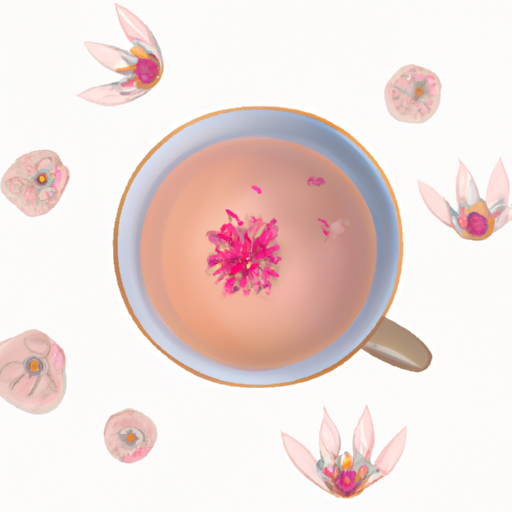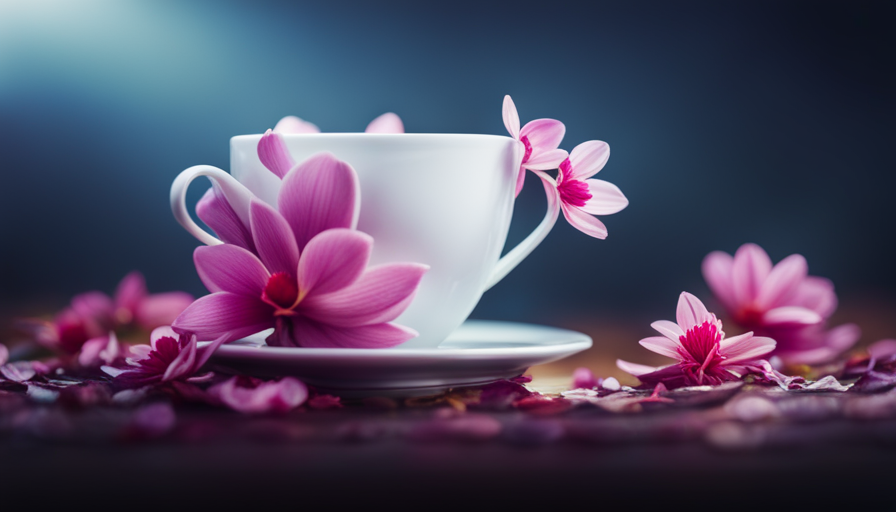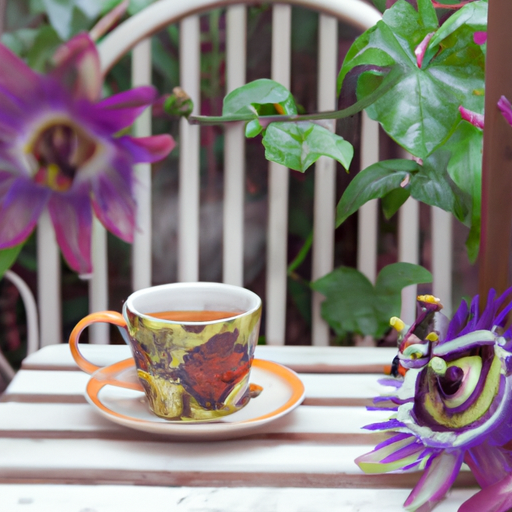Have you ever wondered how to harness the power of nature to promote your overall well-being? Well, I have just the solution for you – echinacea tea made from the beautiful echinacea flower.
This incredible flower has been used for centuries for its medicinal properties, particularly in boosting the immune system and fighting off common ailments like colds and flu.
In this article, I will guide you through the process of making echinacea tea, step by step. From understanding the flower itself to gathering and preparing the flowers, brewing the tea, and even enhancing its flavor, I will provide you with all the information you need to create a delicious and healthful cup of echinacea tea.
So, let’s embark on this botanical journey together and unlock the amazing benefits of echinacea tea!
Key Takeaways
- Echinacea tea is made from the echinacea flower and has medicinal properties.
- Echinacea tea boosts the immune system and fights off colds and flu.
- Proper drying of echinacea flowers concentrates beneficial compounds for tea infusion.
- It is recommended to drink one to three cups of echinacea tea per day and consult with a healthcare professional before use.
Introduction to Echinacea Tea and its Health Benefits
You’re about to discover the incredible health benefits of echinacea tea and why it’s the perfect addition to your daily routine. Echinacea tea, derived from the beautiful echinacea flower, has been used for centuries due to its numerous health benefits.
This herbal tea is known for its immune-boosting properties and its ability to fight off colds and flu. It’s also believed to reduce inflammation and relieve pain. Echinacea tea is rich in antioxidants, which help protect the body against harmful free radicals and promote overall well-being.
The history of echinacea tea dates back to Native American tribes, who used this medicinal herb for various purposes. They believed that echinacea had the power to enhance the immune system and speed up the healing process. Today, modern research has confirmed many of these ancient claims, making echinacea tea a popular choice for those seeking natural remedies.
Understanding the echinacea flower is essential in order to make the perfect cup of tea. It’s important to choose fresh, vibrant echinacea flowers and avoid any wilted or discolored ones. By using the petals and leaves of the flower, you can unlock the full potential of its health benefits.
So, let’s dive into the next section and learn how to make echinacea tea from the flower.
Understanding the Echinacea Flower
As I delve into the topic of understanding the Echinacea flower, I’ll discuss the various types of Echinacea flowers and their distinguishing features.
It’s important to understand the different species of Echinacea, such as Echinacea purpurea and Echinacea angustifolia, as they have varying medicinal properties and levels of effectiveness.
These flowers are known for their immune-boosting properties, as they contain compounds that stimulate the activity of immune cells and enhance the body’s defense mechanisms.
Types of Echinacea flowers
The different varieties of Echinacea flowers are like a vibrant bouquet, each one offering its own unique benefits for brewing a delicious cup of tea.
There are three main types of Echinacea flowers commonly used for making tea: Echinacea purpurea, Echinacea angustifolia, and Echinacea pallida.
Echinacea purpurea: This variety is known for its purple petals and is the most commonly used for medicinal purposes. It’s easy to grow and has a pleasant taste. It’s believed to enhance the immune system and reduce the symptoms of the common cold. Studies have shown that it contains compounds that have anti-inflammatory properties.
Echinacea angustifolia: This variety has pale purple petals and is native to the United States. It’s known for its high concentration of alkamides, which are believed to have immune-boosting effects.
Growing echinacea flowers is relatively simple, requiring well-drained soil and plenty of sunlight. Once the flowers are harvested, they can be dried and used to make a soothing and flavorful tea.
Transitioning into the next section about the medicinal properties of echinacea, these different varieties provide a diverse range of compounds that contribute to their potential health benefits.
Medicinal properties of Echinacea
Immerse yourself in the healing power of Echinacea as its potent properties invigorate your body and soothe your senses. Echinacea has been extensively studied for its medicinal benefits, particularly in the form of Echinacea tea.
Research has shown that Echinacea tea can be effective in boosting the immune system, reducing the severity and duration of cold symptoms, and promoting overall wellness. The active compounds in Echinacea, such as polysaccharides and alkamides, have immune-stimulating and anti-inflammatory properties that help combat infections and support the body’s natural defense mechanisms.
Echinacea tea is a popular remedy for colds due to its ability to relieve congestion, soothe sore throats, and alleviate coughing.
So, as we delve into gathering and preparing echinacea flowers, let’s explore how to harness their medicinal potential.
Gathering and Preparing Echinacea Flowers
When it comes to gathering and preparing Echinacea flowers, I always start by identifying the ripe flowers. I look for petals that are fully opened and vibrant in color, as they indicate that the flower is at its peak potency.
Once I’ve identified the ripe flowers, I carefully harvest them, making sure to leave enough behind for the plant to continue growing. After harvesting, I dry the flowers by hanging them upside down in a well-ventilated area, allowing them to retain their medicinal properties for long-term use.
Identifying ripe flowers
As you gaze upon the vibrant petals, you’ll know the echinacea flowers are ready for harvesting. Identifying ripe flowers is crucial in ensuring the potency of your echinacea tea.
Look for flowers that have fully opened, with petals that are evenly colored and not wilted. The center of the flower, known as the cone, should be a dark brown color. This indicates that the flower has reached its peak medicinal properties.
When harvesting, use clean, sharp scissors or pruning shears to carefully cut the flower stems close to the base. Be sure to leave enough foliage on the plant to allow for its continued growth.
Once harvested, you can proceed to the next section on harvesting and drying techniques, where we will discuss how to preserve the flowers for tea preparation.
Harvesting and drying techniques
To preserve the potent medicinal properties of ripe echinacea flowers, it’s essential to carefully harvest and dry them using specialized techniques.
When harvesting echinacea flowers, it’s important to choose blooms that are fully open and vibrant in color. Avoid picking flowers that are wilted or have started to brown. To harvest, I gently cut the flowers using clean, sharp scissors, leaving about an inch of stem attached. This ensures that the plant can regenerate and continue to produce more flowers.
After harvesting, it’s crucial to dry the flowers properly to maintain their medicinal qualities. One effective drying method is to hang the flowers upside down in a well-ventilated area, away from direct sunlight. This allows the flowers to dry slowly and retain their potency.
Once the flowers are fully dried, they can be used to brew a delicious and healthful echinacea tea.
Brewing Echinacea Tea
When brewing Echinacea tea, it’s crucial to choose the right parts of the flower to ensure maximum potency and flavor. The petals and leaves are typically the preferred parts for tea infusion due to their high concentration of beneficial compounds.
To make a proper tea infusion, a ratio of one teaspoon of dried Echinacea petals and leaves to one cup of boiling water is recommended. Steep the mixture for about 10 minutes before straining and enjoying the herbal goodness.
Choosing the right parts of the flower
Choosing the right parts of the flower is like finding a needle in a haystack, but it ensures the best flavor and benefits for your echinacea tea.
To choose fresh flowers for your tea, look for vibrant petals that are free from blemishes or discoloration. Once you’ve selected the flowers, it’s important to properly dry them to preserve their potency. Start by removing the petals from the flower head and spreading them out in a single layer on a clean, dry surface. Allow them to air dry for several days until they become crisp and brittle. Alternatively, you can use a dehydrator set to a low temperature. This drying process helps concentrate the beneficial compounds in the petals.
Now that you have your dried petals, it’s time to move on to the next step and learn about tea infusion methods and ratios, which will further enhance the flavor and therapeutic properties of your echinacea tea.
Tea infusion methods and ratios
Now let’s explore different ways to infuse your favorite herbal blend and discover the perfect ratios for a truly delightful and invigorating cup of goodness.
Infusing herbs to make echinacea tea can be done using various tea brewing techniques. One common method is the hot infusion method, where you pour boiling water over the dried echinacea flowers and steep for around 10-15 minutes. Another option is the cold infusion method, which involves steeping the flowers in cold water for several hours or overnight. This method is believed to retain more of the plant’s beneficial properties.
To achieve the perfect ratio, start with one teaspoon of dried echinacea flowers per cup of water and adjust to your taste preference. Experiment with different infusion methods and ratios to find the one that suits your palate best.
Moving on to enhancing the flavor of echinacea tea…
Enhancing the Flavor of Echinacea Tea
When it comes to enhancing the flavor of echinacea tea, there are a few key points to consider. One option is to add natural sweeteners or herbs to the tea, such as honey or lemon. These additions can help balance out the earthy taste of echinacea and add a touch of sweetness or tanginess.
Additionally, you can complement the flavor of echinacea tea by incorporating other ingredients, such as ginger or mint, which can provide a refreshing and aromatic twist to the tea.
By experimenting with different combinations, you can create a personalized and flavorful cup of echinacea tea.
Adding natural sweeteners or herbs
To enhance the flavor of your echinacea tea, you can add natural sweeteners or herbs like honey or lemon, which not only provide a delightful taste but also boost the tea’s immune-boosting properties. Did you know that adding a squeeze of lemon to your echinacea tea can increase its vitamin C content by up to 25%?
| Natural Sweeteners | Herbal Additives |
|---|---|
| Honey | Lemon Balm |
| Stevia | Ginger |
| Maple Syrup | Peppermint |
| Agave Nectar | Chamomile |
| Coconut Sugar | Rose Hips |
These natural sweeteners and herbal additives can not only enhance the flavor of your echinacea tea but also provide additional health benefits. They can help balance the earthy taste of echinacea and add a hint of sweetness or a refreshing herbal twist. Complementing flavors with additional ingredients can take your echinacea tea to a whole new level of taste and enjoyment.
Complementing flavors with additional ingredients
Enhance the flavor of your echinacea tea by combining it with additional ingredients that’ll take your taste buds on a delightful journey. Adding complementary flavors to your echinacea tea can create a unique and enjoyable experience.
Consider experimenting with ingredients such as lemon, ginger, or honey to add a hint of citrusy freshness, a touch of warmth, or a natural sweetness, respectively. These flavor combinations not only enhance the taste but also offer potential health benefits. For instance, ginger can aid digestion, while lemon provides a boost of vitamin C.
It’s important to note, however, that not all ingredients may complement echinacea’s flavor profile, so it’s crucial to find the right balance. By understanding the potential side effects and precautions of echinacea tea, you can fully enjoy its benefits.
Understanding the Potential Side Effects and Precautions
It’s important to be aware of the potential side effects and take necessary precautions when making echinacea tea from the flower. While echinacea is generally considered safe for most individuals, it’s essential to understand the potential risks and drug interactions associated with its consumption.
-
Allergic reactions: Some individuals may experience allergic reactions to echinacea, including skin rashes, hives, or difficulty breathing. If you have a known allergy to plants in the daisy family, such as ragweed or marigolds, it’s advisable to avoid echinacea tea.
-
Gastrointestinal issues: Echinacea tea may cause mild digestive issues such as nausea, stomach cramps, or diarrhea in some people. It’s recommended to start with a small amount and gradually increase the dosage to assess your tolerance.
-
Drug interactions: Echinacea can interact with certain medications, including immunosuppressants, corticosteroids, and drugs that affect the liver. Consult with your healthcare provider if you’re on any medications to ensure there are no potential interactions.
Understanding these potential side effects and precautions will help you make informed decisions when incorporating echinacea tea into your daily routine. It’s important to note that these precautions aren’t meant to discourage you from using echinacea tea, but rather to ensure your safety and well-being.
Incorporating Echinacea Tea into Your Daily Routine
When incorporating Echinacea tea into my daily routine, I find it helpful to follow the recommended dosage and frequency guidelines to ensure optimal results. It’s generally advised to drink one to three cups of Echinacea tea per day, spread out evenly throughout the day.
Additionally, combining Echinacea tea with other immune-boosting practices such as regular exercise, a balanced diet, and adequate sleep can further enhance its effectiveness in supporting a healthy immune system.
Recommended dosage and frequency
To fully experience the benefits of echinacea tea, you should steep a handful of the vibrant flowers in boiling water for 10 minutes, then drink a warm cup every morning. This recommended frequency allows for consistent intake of the tea’s active compounds, which can help support immune health.
Echinacea tea is generally considered safe for most people when consumed in moderation. However, it’s important to note that excessive consumption may lead to potential risks such as upset stomach or allergic reactions in some individuals. It’s always best to consult with a healthcare professional before incorporating any new herbal remedy into your daily routine.
By combining echinacea tea with other immune-boosting practices, such as regular exercise and a balanced diet, you can further enhance your overall well-being.
Combining with other immune-boosting practices
After understanding the recommended dosage and frequency of Echinacea tea, it’s important to explore other immune-boosting practices that can be combined with this natural remedy.
Incorporating immune-boosting foods into your diet can have a synergistic effect with Echinacea tea, enhancing its immune-enhancing properties. Foods such as citrus fruits, leafy greens, ginger, garlic, and turmeric are known for their immune-boosting properties and can be easily incorporated into your daily meals.
Additionally, practicing other natural remedies, such as getting enough sleep, managing stress levels, and staying physically active, can further support your immune system.
By combining Echinacea tea with these immune-boosting practices, you can create a holistic approach to supporting your overall health and well-being.
Moving forward, let’s delve into the next section to understand the best methods for storing and preserving Echinacea tea.
Storing and Preserving Echinacea Tea
When it comes to storing and preserving echinacea tea, it’s important to use proper storage containers and conditions.
I recommend using airtight glass jars or containers to keep the tea fresh and prevent moisture from seeping in.
Additionally, it’s crucial to store the tea in a cool, dark, and dry place to maintain its potency and extend its shelf life.
Proper storage containers and conditions
Storing echinacea tea in anything other than airtight containers is like throwing it to the wolves. To preserve its potency and flavor, it’s crucial to choose the right storage containers and create ideal conditions.
Glass jars with tight-fitting lids are the best option for keeping echinacea tea fresh. Avoid using plastic containers as they can leach harmful chemicals into the tea. Additionally, store the jars in a cool, dark place away from direct sunlight and moisture. This will prevent oxidation and maintain the tea’s medicinal properties.
Remember to label the containers with the date of storage to ensure freshness. By following these guidelines, you can extend the shelf life of dried echinacea flowers and continue to enjoy their benefits.
Transitioning into the next section, let’s explore ways to further prolong their lifespan without compromising quality.
Extending the shelf life of dried flowers
After properly storing your dried echinacea flowers, it’s important to take additional steps to extend their shelf life and preserve their quality.
One effective method is to keep them in airtight containers, such as glass jars with tight-fitting lids, in a cool and dark place. This helps to prevent exposure to air, moisture, and light, which can degrade the flowers and reduce their potency.
Additionally, you can add a moisture-absorbing packet, like silica gel, to the container to further protect the flowers from humidity.
Regularly check the flowers for any signs of mold or moisture and discard any that show these symptoms.
By following these guidelines, you can ensure that your dried echinacea flowers remain fresh and potent for an extended period of time.
Now, let’s explore other uses for echinacea beyond making tea.
Exploring Other Uses for Echinacea
Echinacea is not only known for its immune-boosting properties, but it can also be used in various other ways. For example, you can explore its culinary uses by incorporating its petals into salads, soups, or even baking recipes. The vibrant purple petals not only add a pop of color to dishes but also bring a subtle earthy flavor.
Additionally, echinacea can be infused into oils or creams to create homemade skincare products. These products may help soothe skin irritations or promote a healthy complexion. So, if you’re into DIY skincare, echinacea can be a great ingredient to experiment with.
In the realm of self-care, echinacea can be a valuable addition to herbal bath blends. By adding dried echinacea flowers to a hot bath, you can create a calming and rejuvenating experience. The aromatic properties of the flower help to relax the body and mind, while its potential anti-inflammatory properties may provide relief for sore muscles or minor skin irritations.
Now that we’ve explored other uses for echinacea, let’s transition into the subsequent section about enjoying the benefits of echinacea tea.
Conclusion: Enjoying the Benefits of Echinacea Tea
To truly savor the soothing effects of this herbal elixir, indulge in a cup of euphoric echinacea elixir. Echinacea tea offers not only a delightful taste but also a range of health benefits. This vibrant brew is known for its immune-boosting properties, thanks to the presence of antioxidants. These antioxidants help to strengthen the immune system, protecting the body against harmful pathogens and reducing the risk of infections. Additionally, echinacea tea has been found to have anti-inflammatory effects, which can help alleviate symptoms of conditions like arthritis and respiratory issues.
But the benefits don’t stop there. Echinacea tea is also known for its ability to relieve stress and promote relaxation. It contains compounds that can help calm the mind and body, making it the perfect beverage to enjoy after a long, tiring day. Moreover, this herbal tea is rich in vitamins and minerals, including vitamin C, iron, and zinc, which are essential for maintaining overall health and well-being.
To give you a better idea of the health benefits of echinacea tea, here is a table showcasing the various nutrients and their corresponding benefits:
| Nutrient | Benefits |
|---|---|
| Vitamin C | Boosts immune system, aids in collagen production |
| Iron | Supports healthy blood circulation, prevents anemia |
| Zinc | Enhances immune function, promotes wound healing |
Indulging in a cup of echinacea tea is a wonderful way to not only enjoy its delightful taste but also reap its many health benefits. So why not incorporate this herbal elixir into your daily routine and experience the goodness it has to offer?
Frequently Asked Questions
What is the best time of day to drink echinacea tea?
The best time to drink echinacea tea is in the morning or early afternoon. This is because echinacea tea can have stimulating effects, which may interfere with sleep if consumed later in the day.
However, it’s important to note that echinacea tea is generally safe for most people, but pregnant women should exercise caution. Echinacea tea may have potential side effects during pregnancy, so it’s advisable to consult with a healthcare professional before consuming it.
Can I use dried echinacea flowers to make the tea?
Sure, you can definitely use dried echinacea flowers to make tea! Although it might sound retro, dried flowers are a convenient option for brewing a cup of this herbal goodness. Echinacea tea, derived from the dried flowers, is known for its immune-boosting properties. Packed with antioxidants and anti-inflammatory compounds, it can support your overall health and well-being. So go ahead and steep those dried flowers for a soothing and beneficial cup of echinacea tea!
How long does it take for echinacea tea to start showing its health benefits?
It typically takes a few weeks of regular consumption of echinacea tea before its health benefits begin to show. The start time can vary depending on an individual’s immune system and overall health.
Echinacea is known for its immune-boosting properties and can help alleviate symptoms of the common cold, such as sore throat and congestion. Its anti-inflammatory and antioxidant properties also contribute to its health benefits.
Can I add sweeteners or milk to enhance the flavor of echinacea tea?
Sure, go ahead and ruin the natural, earthy flavor of echinacea tea with sweeteners or milk. Because who wants to experience the true herbal taste when you can mask it with artificial sweetness?
As for adding milk, well, it may dilute the potency of the tea, reducing its health benefits. But hey, if you’re more interested in a creamy, sugary concoction than reaping the potential immune-boosting effects, go for it.
Are there any specific precautions for pregnant or breastfeeding women when consuming echinacea tea?
When it comes to echinacea tea, pregnant and breastfeeding women should take certain precautions. Echinacea is generally considered safe for most individuals, but it’s always best to consult with a healthcare professional before consuming it. Some studies suggest that echinacea may stimulate the immune system, which could potentially affect pregnancy or breastfeeding.
Additionally, echinacea may cause allergic reactions in some people, so it’s important to be cautious. Overall, it’s crucial to prioritize the health and well-being of both mother and baby.
Conclusion
In conclusion, after delving into the world of Echinacea tea and its health benefits, I’m convinced that incorporating this herbal remedy into my daily routine is a wise decision. The process of gathering and preparing the Echinacea flowers was a fascinating experience, and brewing the tea allowed me to unlock its medicinal properties.
By enhancing the flavor with a touch of honey or lemon, I was able to enjoy the tea even more. Storing and preserving the tea will ensure that I can continue to reap its benefits for a long time. Exploring other uses for Echinacea, such as making tinctures or salves, further expands its versatility.
Overall, I’m excited to embrace the power of Echinacea tea and let it work its magic in my life. As the saying goes, "A stitch in time saves nine," and by incorporating Echinacea tea into my daily routine, I’m taking proactive steps towards maintaining my health and well-being.










